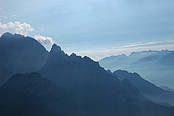The Roman Period
At the end of the III century BC the Roman conquest of the current Friuli Venezia Giulia and the surrounding area, Istria began. It was long and difficult due to the resistance opposed by the Istrians and Liburni against which Rome erected the bulwarks of Aquileia (181 BC), Triest and Pola. The Romans completely conquered Friuli only in 186 BC. The first trading relations with the indigenous populations date back to this period. The relations constantly improved such that, according to some chronicles, a King called Vocio sent to Julius Caesar for the first time - during one of the battles in which he was involved - auxiliary troops. Notwithstanding this, these populations were only fully subdued after the expedition of Caio Julius Caeser Ottaviano who baptised the Alps in the area in his honour with the name of Giulie . And it was the same proconsul, who, having become Emperor, including Friuli and Istria in the Decima Regio (=tenth region of the Roman Italy), together with Venice and that part of the Giapidia (now Slovenia), with Easter centre in Aquileia. Emperor Tiberio and then Druso subdued the Eastern Alpine Lands and formed the central and coastal Noricum Province (now Austria). There are many traces of Roman rule in the Tarvisio area : some toponyms, tombstones and votive stones with beautiful inscriptions, money and various objects, traces of a "statio" (indicating that there was once a customs, military, post and refreshment station), just to give a few examples. Around 166 AD, there were incursions by the Germanic and Slav populations against whom Emperor Marco Aurelio led a victorious expedition. Then there were invasions by Alarico's Visigoths (401) and Attila's Huns (452).







